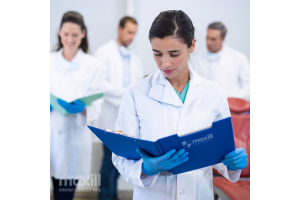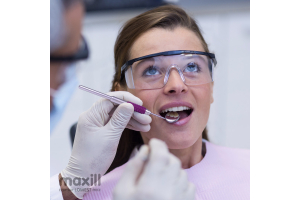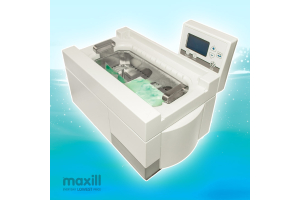Antibiotic Awareness and Stewardship

Imagine living in an era without antibiotics.
Penicillin was discovered by Alexander Fleming in 1928, before that people died from many opportunistic bacterial infections. Even minor cuts and scrapes could be fatal 80% of the time if colonized with Staphylococcus aureus. Streptococcus pyogenes caused half of all post-birth deaths, and infectious diseases such as tuberculosis and bacterial pneumonia were rampant killers. 1 The medical and scientific breakthrough in antibiotic development has created a healthy environment with preventive and curative options, protection from fatal diseases, and the ability to add an infection prevention safeguard during and after surgical procedures.
This is all terrific news; however, the overuse and misuse of these life-saving antibiotics over the past 100 years are now a significant reason that many people are dying or staying tragically ill from antimicrobial-resistant infections. The resistance of pathogens to the antimicrobials we have now and the lack of new antibiotic research and development may put us back in a time when we have no access to effective antibiotics.
What is antimicrobial resistance (AMR)?
Antimicrobial resistance occurs when pathogens, including bacteria, viruses, parasites, and fungi, change at a molecular level so quickly that the medications used to treat and control them become ineffective. This change results in the formation of “superbugs” that do not respond to drug treatment. Although we may encounter many pathogens in the dental field, antibiotics-resistant bacteria are of the most significant concern, as many dental diseases are based on microbiome imbalance. One powerful way that antibiotic resistance (ABR) occurs is the unnecessary and overexposure to antibiotics.
Antibiotics work to kill the disease-causing bacteria, but other bacteria that are not affected by a specific antibiotic will continue to reproduce; this can upset the natural microbiome environment leading to the colonization of bacteria that can cause disease or health issues. Antibiotic resistance is not just a human problem; the overuse of antibiotics in animal farming increases the number of new “superbugs ."It is not the person or the animal that becomes resistant to the antibiotics, but the bacteria. Antibiotic-resistant infections can lead to more extended hospital stays higher medical costs and more deaths.
Resistance as a global problem
Antibiotic resistance is a global issue. There is a need to initiate antibiotic stewardship worldwide. Countries, governments, and health agencies need to work together to stop the spread of antibiotic resistant infections and work to produce new drugs. Some countries have reported that more than 42% of infections are resistant to standard antibiotic therapy.
If the antibiotic resistance (ABR) continues, it is probable that by 2050, infections that are resistant to antibiotics will be the number one cause of death globally, with 10 million people dying every year. 2
Resistance is a personal problem for everyone.
ABR does not discriminate; it is a universal problem that can affect anyone at any time or age. Many cases exist, and there is a need for individuals always to follow the advice of their healthcare provider when taking antibiotics. It is crucial for healthcare providers to follow prescribing guidelines and for patients to follow instructions closely.
Antibiotic-resistant bacteria can also be transmitted from one individual to another person, animal, or environment.
Resistance and the importance of dental teams
Dental infections left untreated can quickly spread to the bloodstream or vital organs. Prompt care and treatment of dental problems can eliminate the need for antibiotic prescriptions. Extraction of a non-restorable tooth or endodontic therapy for acute pulpitis can remove the source of infection and pain without needing antibiotics.
One roadblock to prompt diagnosis and treatment is the lack of access to care for some of the most vulnerable members of society, including children, the elderly, and the poor. Those populations that must wait longer for care are often prescribed more antibiotics than they usually would if they were able to get timely treatment.
The dental profession is responsible for approximately 10% of antibiotic prescriptions globally. Overuse of antibiotics in dentistry is a significant factor in ABR. A United Kingdom study found an 80% rate of unnecessary antibiotics for treating acute dental problems. A U.S. study also found an 80% rate of inappropriate use of antibiotics for pre-med prophylaxis before dental treatment.
Antibiotic needs should be individually recommended. For example, not all patients with artificial joint placement should uniformly be given prophylactic premedication. For dentistry, antibiotics should be used only when strictly necessary. The act could amount to clinical negligence when antibiotic prescribing guidelines are not followed or prescribed when there is no clinical basis for the patient’s best interest.
The essential dental role in antibiotic stewardship
There are three critical areas for the dental professional's contribution to global efforts to suppress (ABR). Those include:
- Raising awareness
- Infection prevention and control Antibiotic stewardship (optimizing the use of antibiotics)
Raising awareness
It is sometimes a challenge to change the way dentistry has prescribed antibiotics in the past. For years we have prescribed antibiotics for anyone with a toothache, and we are still blanketly covering everyone with an artificial joint with a heavy dose of antibiotics before treatment. We get used to doing everything “the way it always has been done ."Communicating the theory and ways to avoid resistance can take time and effort. Antibiotic resistance evidence-based education and continued training and development will get us all on the same page to understand and change how we use antibiotics.
Our patients must also become aware that the mighty antibiotic is not the easy answer to treatment, and dental personnel must be able to communicate and manage patients' beliefs and concerns. Pain relief is best achieved with dental treatment procedures, and prevention of oral diseases reduces the chances of infection. If antibiotics are prescribed, the patient needs to be educated on the prescribed antibiotic's proper use, duration, and dose.
Infection prevention and control
Infection prevention and control involve methods, techniques, and procedures that prevent harm caused by pathogens to healthcare providers and their patients. In practice, adhering to standard procedures, including hand hygiene, equipment sterilization, and safe handling of sharps prevents cross-contamination and infection from person to person.
Up-to-date vaccination status for personnel is also a beneficial infection prevention and control guideline. Educating our patients on their role in maintaining adequate oral hygiene by accessing preventive treatment, and reduction of sugar consumption are important ways to fight the need for antibiotics.
Stewardship
The 2019 FDI Policy Antibiotic Statement on Antibiotic Stewardship in Dentistry has adopted the following definition: “Antibiotic stewardship is a coherent set of actions which promote appropriate use of antibiotics, i.e., in ways that ensure sustainable access to effective therapy for all who need them." In other words, diagnosing and treating dental issues by procedure rather than antibiotic drugs whenever possible and using antibiotics carefully and responsibly and only when essential.
All people are susceptible to antibiotic resistance. It has become a global concern compared to climate change and terrorism. It is time for everyone to make changes to the proper and responsible use of antibiotics. For the dental world, we need to make better strides to rein in extravagant antibiotic use through WHO global action plan objectives and FDI antibiotic stewardship in dentistry policy:
- Reduce the incidence of infection through infection prevention measures
- Optimize the use of antimicrobial medications in human and animal health
- Strengthen the knowledge of evidence
- Global investment improves awareness and understanding of resistance through communication
- in new medicine, diagnostic tools, vaccines, and other interventions2
It will take some time and a change of mindset but together, we can control the overuse of antibiotics that are leading to higher medical costs, extended hospital stays, and preventable deaths.
References
- 1. “Antibiotics 1928-2000” Australian Broadcasting Corporation, Accessed 29 November 2022.
- 2. Thompson, W., Williams, D., Pulcini, C., Sanderson, S., Calfron, P., & Verma, M. (2020). FDI white paper: The essential role of the dental team in reducing antibiotic resistance. FDI World Dental Federation.







